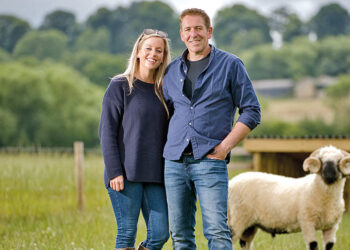Ria Osborne
The groom’s cake tradition, explained
In 1989, the film Steel Magnolias introduced the world to the American South’s most unhinged wedding accoutrement: the groom’s cake. The movie’s particular red velvet cake is an icon. It’s shaped like an armadillo, coated in gray icing, and cut into thick, gruesome-looking slices by the eternally cranky Ouiser Boudreaux, played by Shirley MacLaine. And even though it was the (literal) butt of the joke, the armadillo cake — modern iterations of it, anyway — can still be found on countless wedding inspo boards all over Pinterest.
As someone from the South, I saw groom’s cakes at nearly every wedding I went to growing up. Usually, they were just regular-looking cakes, served on a separate table away from the main-attraction wedding cake. It was a tradition that made perfect sense — the wedding cake is often painstakingly designed by the bride to her exact specifications, so why shouldn’t the groom get his own cake? And besides, who doesn’t want a slice of moist red velvet when the other option is a boring white cake coated in fondant? It wasn’t until I was an adult that I realized that having a separate cake for the groom is mostly a Southern phenomenon. But it didn’t start that way.
The origin of the groom’s cake lies in Victorian England, at a time when weddings typically had three cakes — one served to the guests, one for the groomsmen, and another for the bridesmaids — instead of the single, giant cake common at weddings today. The tradition made its way to the American South as British colonists arrived in the region, and over time morphed into a single groom’s cake served alongside a big wedding cake. One custom held that these cakes should be divvied up among the unmarried women at the wedding, the slices placed under their pillows as a good luck charm as they sought their own husbands. In the Southern tradition, groom’s cakes were also baked with richer flavor profiles, which have long been coded as more “masculine” than delicate white wedding cake. That still seems to be the case: bakers say that red velvet and chocolate continue to be among the most common groom’s cake flavors.
Through the decades, just as most other aspects of the wedding have evolved with time, so have groom’s cakes. For some, they’re a beloved, long-standing tradition, and for others, they’re simply a way for grooms to express their hobbies and interests. As such, it’s not uncommon to see a cake shaped like a college football team’s helmets or covered in camouflage icing or bedecked with the groom’s favorite bottles of booze. But in 2023, when weddings can be as inclusive and creative as the people getting married want them to be, a tradition that was at one time rooted in finding a bunch of unlucky spinsters their dream man is increasingly feeling dated — for most, anyway.
Janean Carlton has been baking since she was in high school, and opened Carlton’s Cakes in Atlanta in 2015. A born-and-raised Southerner, Carlton is a proponent of the tradition, if only because many weddings in the South are very bride-centric. “I hate it when I see the groom saying, ‘Oh, honey, it doesn’t matter. Just whatever you think,” Carlton says. “I always want them to go for it, because it’s often their last chance to really have some kind of say in the wedding.”
As a baker, Carlton also just really likes making groom’s cakes. She says they offer the ability to be more creative and flex her skills as a sculptor and artist, whether she airbrushes character art onto a massive World of Warcraft cake or crafts ice cubes out of isomalt sugar for a cake shaped like a bucket of cold beer. “It’s a place to do something different and artistic,” she says. “You can be very, very, very unique.”
Carlton says that when she started her business, she made more groom’s cakes. Now, only about half of the weddings she bakes for request one. Many couples are passing on the groom’s cake due to budget restrictions. And while some Southerners view the groom’s cake as the “last bastion of gentility,” others think it’s an outdated tradition that’s not worth continuing — or at the very least, not worth spending several hundred dollars on when there are so many other expenses involved in throwing a wedding.
The wedding planner, or “wedding designer,” as they’re often called now, isn’t helping. Especially at big-budget, blockbuster weddings, these planners have a very specific vision for how the wedding is going to look. “They don’t want the groom’s cake because they think it’s going to take away from the whole aesthetic of the wedding,” Carlton says. “So the groom’s cake ends up kind of shoved off to the side during the wedding, and I hate that.” She does, however, note an increasingly popular trend in which couples serve a groom’s cake at the rehearsal dinner, where it can shine on its own without distracting from the actual wedding cake.
At Earth and Sugar in West Palm Beach, Florida, groom’s cakes make up an even smaller percentage of the company’s weddings — about 20 to 30 percent, and rarely at weddings with two grooms. According to marketing manager Mikiayla Dames, the weddings that include groom’s cakes tend to have room for a bigger cake budget. “Sometimes a couple will do a smaller wedding cake to prioritize the groom’s cake, but a lot of times we see it in weddings that have larger budgets,” Dames says. “It just depends on the size of the wedding, what they’re looking for, and if a groom’s cake is something that is important to them.”
For Paul Algu, an environmental scientist who lives in New Orleans and was married in nearby Baton Rouge last year, having a groom’s cake was a no-brainer. Algu grew up Hindu and Christian in Louisiana, and every wedding he went to in the South had a groom’s cake. “When we got down to planning, my wife asked if we were going to have a groom’s cake, and I didn’t even think not having one was an option,” he says. “We were kind of doing the cakes on a budget, so it couldn’t be an insane tiered cake, but we still wanted to have something good.”
Algu and his wife contacted Baton Rouge bakery Cake That for his groom’s cake, which was flavored with local strawberries, shaped like the state of Louisiana, and frosted in bright yellow icing to mimic the logo of the Masters, the long-running Georgia golf tournament. A tiny golf flagstick with a red flag sticks out of the Louisiana-shaped cake in the spot where Baton Rouge might be to mark the location of the couple’s wedding.
Like the tradition itself, Algu’s groom’s cake is deeply Southern — and especially personal for him. “Golf was the thing that really connected my dad, my brother, and I,” he says. “We played it our entire lives, and we still go out there and have a good time, so I thought this was just the perfect cake for our wedding.” Now that his first anniversary is approaching, Algu and his wife plan to celebrate year one with cupcakes decorated to look like his groom’s cake.
But even as the groom’s cake fades from the Southern wedding, bakers — and brides — are still looking for new ways to keep the tradition alive. In recent years, Dames has seen an uptick in brides choosing to surprise their groom with a cake, often at the pre-wedding rehearsal dinner, which adds a little bit of fun and mystery to a day that’s supposed to be romantic and joyous but is often intense and overwhelming.
It seems like the groom’s cake tradition isn’t changing so much as the wedding is changing. When Steel Magnolias was released in 1989, same-sex marriage was illegal in all 50 states, and only 14 percent of women kept their own last names after marrying their husbands. Now, people with all gender identities are entitled to marry under the law, and nearly 30 percent of women are keeping their names. Considering that weddings are one of the original bastions of patriarchy, it’s perhaps not surprising that this tradition is evolving much more slowly than the rest of society.
But while small desserts and trendy sweets like hand pies and doughnut boards will come and go, the groom’s cake will likely hold a place in the hearts of many Southerners forever. And that’s not because we have any deep affinity for the groom’s cake itself, really, but we sure do love perpetuating a tradition just for the sake of perpetuating a tradition. If Meemaw and Peepaw had a groom’s cake at their humble nuptials in 1932, then by God, we will too. Even if that means having a red velvet armadillo as part of the fanciest day of our lives.
Ria Osborne is a Brooklyn-based food photographer by way of London.
Liberty Fennell is a London-born, New York City-based food stylist and recipe developer.
Sonny Ross is an illustrator based in Manchester, U.K. They love drawing food as much as cooking it but not as much as eating it. They work across editorial, publishing, textiles and packaging and in their downtime enjoys such hobbies as: sleeping.
Copy edited by Leilah Bernstein













